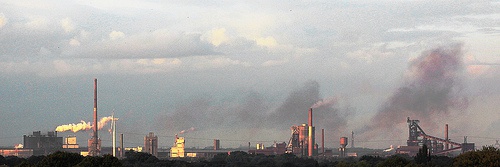Particulate matter and human health

High concentrations of airborne particulate matter (PM) can have severe impacts on human health, such as premature deaths from cardio-pulmonary and lung cancer diseases. PM is a general term used for a mixture of solid and liquid aerosol particles of different size and chemical composition and is commonly classified as PM2.5 and PM10, i.e., the fraction of the total PM with an aerodynamic diameter less than 2.5 and 10 μm, respectively. In Europe, over 600,000 premature deaths each year from cardiopulmonary and lung cancer diseases are attributed to anthropogenic PM exposure causes.
Studies have shown that local-to-regional scale pollutant concentrations can be influenced by large-scale atmospheric circulation patterns, such as the North Atlantic Oscillation. The NAO commonly refers to swings in the atmospheric pressure difference between the subpolar and the subtropical North Atlantic. The NAO-Index (NAOI) is traditionally defined as the difference in the normalized sea level pressure anomalies between either Lisbon, Portugal, or Ponte Delgada, Azores, and Stykkisholmur/Reykjavik, Iceland. The NAOI is positive when the pressure contrast between the two centers of action strengthens, leading to a northward shift of the storm track (i.e., higher-than-averageWest-East transport) and more stable conditions over southern Europe. The NAOI is negative when the pressure contrast weakens and more storms enter the Mediterranean basin.
In winter months (December to March) the NAO dominates the atmospheric variability over Europe and PM concentrations are of most concern for public health, especially in southern Europe. The winter NAO has shown an upward trend during winter in the 1980s and 1990s; climate model predictions suggest that the positive trend in winter NAO will continue in the coming decades. Cities located in the Mediterranean area may be penalized by a NAO positive shift in a future climate, whereas central-northern and eastern Europe will benefit from such a shift. One of the areas most negatively affected by climate change is the Po-valley in Northern Italy, which is both heavily urbanized (e.g., Milan, Turin, Bologna) and also one of the largest industrialized regions in Europe. Because of its specific morphology, this area is also one of the most polluted regions in Europe, and climate change may aggravate this situation. Additional PM emission reduction measures may be necessary for those countries and cities in southern Europe, likely to experience NAO driven increases in mortality, in order to counteract these particular climate disbenefits.
Source: Pausata et al., 2013. Geophysical Research Letters 40: 4074–4080.
Photo: Pascal (www.flickr.com)



